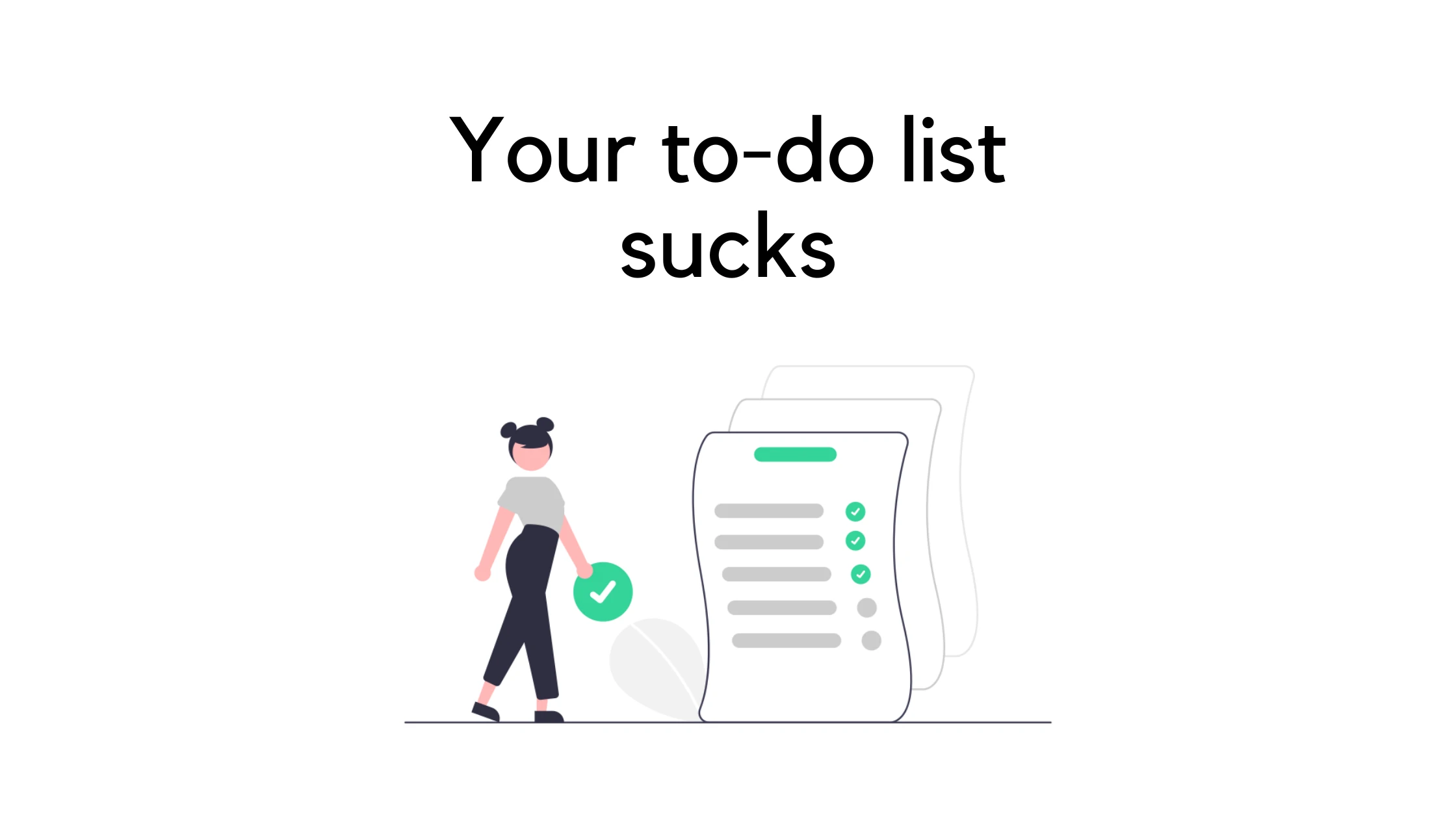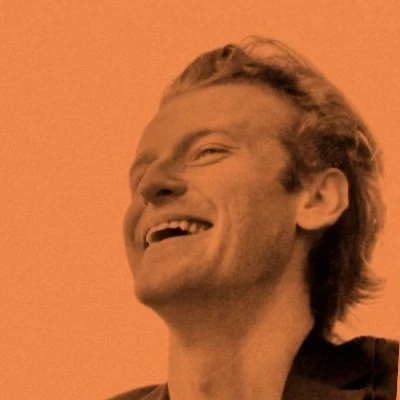
Your to-do list sucks. Let's fix it.

Max Girkins
7 minute read
2 years ago
If you’re anything like me, you need a to-do list system in your life to make sure that everything is getting done, being remembered, and being prioritized. Whether it’s an old-school system of pen and paper, or an app on your phone like Google Keep, there’s a good chance that what you’re using now isn’t as good as it could be and you’re wasting a lot of time and energy on it. I find wasting time and energy on things that don’t matter to be hugely frustrating so I’ve spent a lot of time thinking about how to make my to-do list system as efficient as possible. Here are some thoughts on the problems with existing to-do list apps/accepted wisdom and how to fix them.
Why do they suck?
To-do lists are conventionally 1 dimensional. It’s great for a shopping list where all the items are of roughly the same complexity to tick off (unless your list contains sugar and some real niche seaweed that can only be bought from a specialty shop during a full moon). It sucks if you have a list of tasks that are of varying complexity.
If your to-do list for the day is “write a blog post”, “do the laundry”, “wash hair”, then you’re going to struggle as soon as you reach “write a blog post”. This is because the task is not nearly specific or planned out enough for you to get started without a huge cognitive strain to think about all the steps that need to be taken to accomplish that task. The problem is that if you write down all those steps in a conventional list then it is going to be enormous and you’re going to be overwhelmed and anxious. And what happens if you don’t finish all the steps to complete “write a blog post” in one day? You feel bad, and it makes you think that you’ve been unproductive when you may have just bitten off more than you can chew. Having a task like “write a blog post” that could take days to complete is terrible for our sense of productivity as it lingers on our list. We all know how nice it is to get to the end of the day having ticked all the tasks off our list and seeing a blank slate for tomorrow. It’s a great feeling, and it’s a feeling that we should be able to have every day. The problem is that we’re not using the right tools for the job.
To-do lists don’t have a way to show you just what you need to do today. To effectively use your day you should do some level of planning in advance as planning and doing are two different modes of thinking and it’s good to batch them for maximum efficiency. A normal to-do list has many tasks on it that you aren’t going to complete today but part of your brain will think about when you look at the list. You want as much of your focus as possible to be on what you need to do today, not the random errand you need to do for your neighbor on the weekend.
Many task management apps have lots of automated workflows that ostensibly help keep you productive. In reality, many of those automations are either a distraction or in fact harmful to our long-term productivity as they teach us bad productivity habits. For example, if you have a task that is due today, but you don’t complete it, then it will automatically be moved to tomorrow. This is a problem because you can just put it off until tomorrow knowing that you’ll be reminded, it’s enabling your lazy brain to have an excuse for putting off the task easily. This leads to a cycle of doing things at the very last minute and then half-assing them.
To-do lists aren’t good if your priorities change. If you have a list of tasks you need to do today and then something urgent comes up, you have to go through the list and shuffle everything around to fit the new task in. This is a waste of time and energy, especially if you’re using your list to plan a big project and suddenly have to remove loads of tasks for a feature that was suddenly dropped.
To-do lists are not good for planning projects. If you have a big project that you’re working on, you’re going to need to break it down into smaller tasks. This is a good thing to do, but it’s not good to have all those tasks on your to-do list at once. It’s overwhelming and it’s not going to help you get the project done any faster.
How to fix them
Add a 3rd dimension (hierarchy). Adding collapsable subtasks to to-do lists is great as it immediately solves the problem of having tasks of different complexities next to each other. You can easily see how complex a task is based on how many levels of subtasks it has and plan accordingly from there.
Make it easy to cherry-pick tasks for your day. You need to be able to quickly add tasks to your plan for the day in such a way that you won’t be able to see all your other tasks staring you in the face all day. This is essential as it cuts down the difficulty in focusing from having to ignore lots of things to simply taking each task one at a time. Bonus points if you can prioritize your daily tasks in the morning and then not touch them unless you’re ticking them off.
Break down your biggest projects into smaller and smaller chunks so they effectively work with the two points above. You should be able to see which areas of your project need to be worked on to accomplish various goals. This is a great way to make sure that you’re not forgetting anything and that you’re not getting overwhelmed by the size of the project. It’s also really useful nesting projects so that when you’re planning your day you can grab tasks from any level of the hierarchy you feel comfortable completing in a day. That way there’s no excuse for not completing your daily list.
Keep it simple. Don’t add workflows that are going to make you lazy, they will seem like a great idea initially but will in fact hinder you in the long run, and also often end up being useless when not used in a very specific way. The power of your to-do list should be coming from the way it reflects your mental model for how you want to get things done, not from the app itself. The best to-do list app is the one that gets out of your way and lets you get things done.
What I use
I have tried many to-do list systems over the past 10+ years. I first used pen and paper as it was natural and flexible however I swiftly ran into problems when I wanted to prioritize tasks (you can’t exactly drag and drop tasks around the list). I then switched to Wunderlist (RIP) which was a huge step up for my productivity and while I was a student at school it worked perfectly as I never really had to plan anything very complex. When I reached university Wunderlist had been acquired by Microsoft and folded into Microsoft to do, it is still a good app but at university, I was planning more complex projects and had outgrown it. I started looking at task management platforms but they were all way too complicated and messy for what I needed, and often focused more on businesses than individuals, so I came up with my own simple solution. I used a text file with indentation to represent subtasks and my productivity skyrocketed! The power came not from a complex app but from a simple structure that worked for me. I used it for a few years before deciding that it was a pain to sync across my devices, didn’t allow me to schedule things easily, didn’t have a natural way to cherry-pick my daily tasks, and wasn’t particularly good for prioritizing easily.
Finally, I decided to build my own app - Tatask - you should check it out. It’s designed to work as the perfect to-do list/task management app for your life. Everything is nestable, you can add tasks to your daily plan with a click, you can prioritize tasks, and you can schedule tasks for a specific time. I use it every day and it’s the best to-do list app I’ve ever used. I hope you find it useful too.